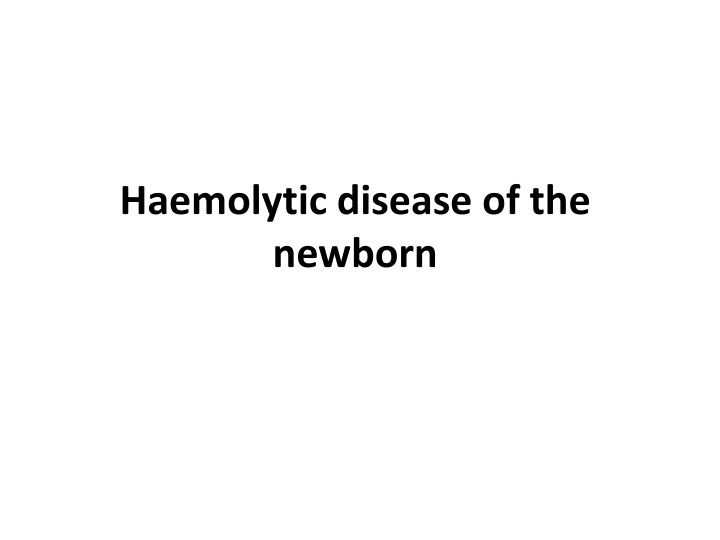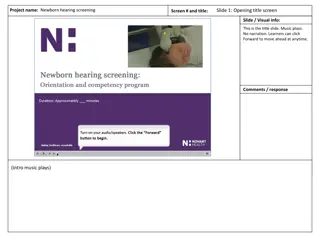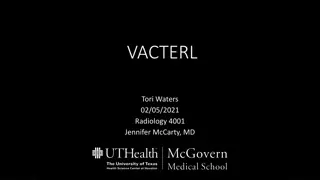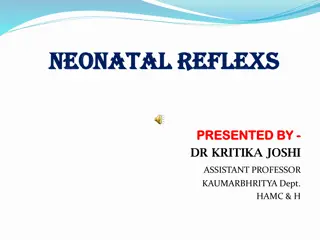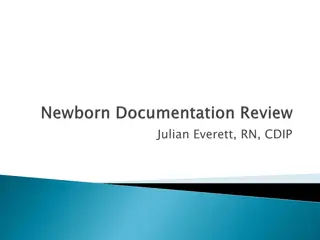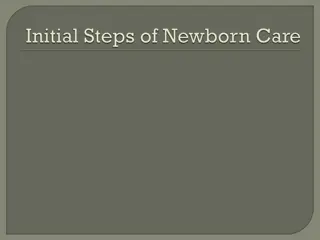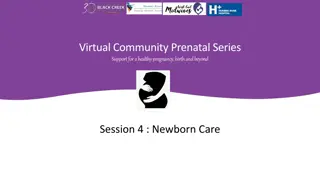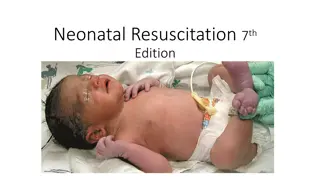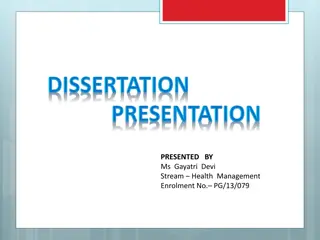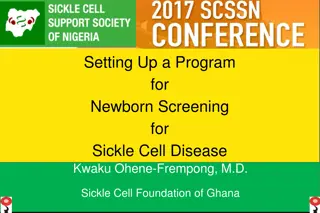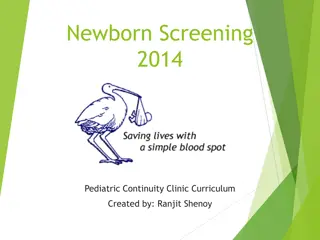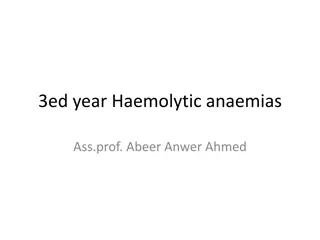Haemolytic Disease of the Newborn
Haemolytic disease of the newborn (HDN) occurs when maternal IgG antibodies cross the placenta, leading to destruction of fetal red cells. Rh(D) incompatibility is a common cause, but proper management and prevention strategies can reduce the risk of complications for both the mother and baby.
Download Presentation

Please find below an Image/Link to download the presentation.
The content on the website is provided AS IS for your information and personal use only. It may not be sold, licensed, or shared on other websites without obtaining consent from the author.If you encounter any issues during the download, it is possible that the publisher has removed the file from their server.
You are allowed to download the files provided on this website for personal or commercial use, subject to the condition that they are used lawfully. All files are the property of their respective owners.
The content on the website is provided AS IS for your information and personal use only. It may not be sold, licensed, or shared on other websites without obtaining consent from the author.
E N D
Presentation Transcript
Haemolytic disease of the newborn
HDN is the result of red cell alloimmunization in which IgG antibodies passage from the maternal circulation across the placenta into the circulation of the fetus where they react with fetal red cells and lead to their destruction. Anti D antibody is responsible for most cases of severe HDN although anti c, anti E, anti K and a wide range of other antibodies are found in occasional cases (see Table 30.3). Although antibodies against the ABO blood group system are the most frequent cause of HDN this is usually mild.
Rh haemolytic disease of the newborn When an Rh D negative woman has a pregnancy with an Rh D positive fetus, Rh D positive fetal red cells cross into the maternal circulation (especially at parturition and during the third trimester) and sensitize the mother to form anti D. The mother could also be sensitized by a previous miscarriage, amniocentesis or other trauma to the placenta or by blood transfusion. Anti D crosses the placenta to the fetus during the next pregnancy, coats RhD positive fetal red cells and results in reticuloendothelial destruction of these cells, causing anaemia and jaundice. If the father is heterozygous for D antigen, and mother RhD negative there is a 50% probability that the fetus will be D positive. The fetal Rh D genotype can be established by polymerase chain reaction (PCR) analysis for the presence of Rh D in a maternal blood sample.
The main aim of management is to prevent antiD antibody formation in Rh D negative mothers. This can be achieved by the administration of small amounts of anti D antibody which mop up and destroy Rh D positive fetal red cells before they can sensitize the immune system of the mother to produce anti D.
Prevention of Rh immunization At the time of booking, all pregnant women should have theirABO and Rh group determined and serum screened for antibodies at least twice during the pregnancy. All non sensitized Rh D negative women should be given at least 500 units (100 g)of anti D at 28 and 34 weeks gestation to reduce the risk of sensitization from fetomaternal haemorrhage.
Fetal Rh D typing from DNA in maternal blood can be used before 28 weeks. If the fetus is Rh D negative, no further anti D prophylaxis is needed. In addition, at birth the babies of Rh D negative women who do not have antibodies must have their cord blood grouped for ABO and Rh. If the baby s blood is Rh D negative, the mother will require no further treatment. If the baby is Rh D positive, prophylactic anti D should be administered to the mother at a minimum dose of 500 units intramuscularly within 72 hours of delivery.
A Kleihauer test is performed. This uses differential staining to estimate the number of fetal cells in the maternal circulation (Fig. 31.5a). If the Kleihauer is positive many centres will perform flow cytometry for a more accurate estimate of the volume of feto maternal haemorrhage (FMH) (Fig. 31.5b). The chance of developing antibodies is related to the number of fetal cells found. The dose of anti D is increased if there is greater than 4 mL transplacental haemorrhage. Anti D IgG (125 units) is given for each 1 mL of FMH greater than 4 mL.
Sensitizing episodes during pregnancy Anti D IgG should be given to Rh D negative women who have potentially sensitizing episodes during pregnancy: 250 units is given if the event occurs up to week 20 of gestation and 500 units thereafter, followed by a Kleihauer test. Potentially sensitizing events include therapeutic termination of pregnancy, spontaneous miscarriage after 12 weeks gestation, ectopic pregnancy and invasive antenatal diagnostic procedures.
Treatment of established antiD sensitization If anti D antibodies are detected during pregnancy they should be quantified at regular intervals. The clinical severity is related to the strength of anti D present in maternal serum but is also affected by such factors as the IgG subclass, rate of rise of antibody and past history. The development of haemolytic disease in the fetus can be assessed by velocimetry of the fetal middle cerebral artery by Doppler ultrasonography, as increased velocities correlate with fetal anaemia (Fig. 31.6). If anaemia is detected, fetal blood sampling and intrauterine transfusion of irradiated Rh D negative packed red cells may be indicated
Clinical features of HDN 1 Severe disease Intrauterine death from hydrops fetalis 2 Moderate disease The baby is born with anaemia and jaundice and may show pallor, tachycardia, oedema and hepatosplenomegaly. If the unconjugated bilirubin is not controlled and reaches levels exceeding 250 mol/L, bile pigment deposition in the basal ganglia may lead to kernicterus central nervous system damage with generalized spasticity and possible subsequent mental deficiency, deafness and epilepsy. This problem becomes acute after birth as maternal clearance of fetal bilirubin ceases and conjugation of bilirubin by the neonatal liver has not yet reached full activity. 3 Mild disease Mild anaemia with or without jaundice.Investigations will reveal variable anaemia with a high reticulocyte count; the baby is Rh D positive, the direct antiglobulin test is positive and the serum bilirubin raised. In moderate and severe cases, many erythroblasts are seen in the blood film ,this is known as erythroblastosis fetalis.
Treatment Exchange transfusion may be necessary; the indications for this include severe anaemia (Hb <100 g/L at birth) and severe or rapidly rising hyperbilirubinaemia. More than one exchange transfusion may be required and 500 mL is usually sufficient for each exchange. The donor blood should be less than 5 days old, CMV negative, irradiated, Rh D negative and ABO compatible with the baby s and mother s serum. Phototherapy (exposure of the infant to bright light of appropriate wavelength) degrades bilirubin and reduces the likelihood of kernicterus
ABO haemolytic disease of the newborn In 20% of births, a mother is ABO incompatible with the fetus. Group A and group B mothers usually have only IgM ABO antibodies . The majority of cases of ABO HDN are caused by immune IgG antibodies in group Omothers. Although 15% of pregnancies in white people involve a group O mother with a group A or group B fetus, most mothers do not produce IgG anti A or anti B and very few babies have severe enough haemolytic disease to require treatment. Exchange transfusions are needed in only1 in 3000 infants. The mild course of ABO HDN is partly explained by the A and B antigens not being fully developed at birth and by partial neutralization of maternal IgG antibodies by A and B antigens on other cells, in the plasma and tissue fluids.
In contrast to Rh HDN, ABO disease may be found in the first pregnancy and may or may not affect subsequent pregnancies. The direct antiglobulin test on the infant s cells may be negative or only weakly positive. Examination of the blood film shows: autoagglutination spherocytosis, polychromasia and erythroblastosis
